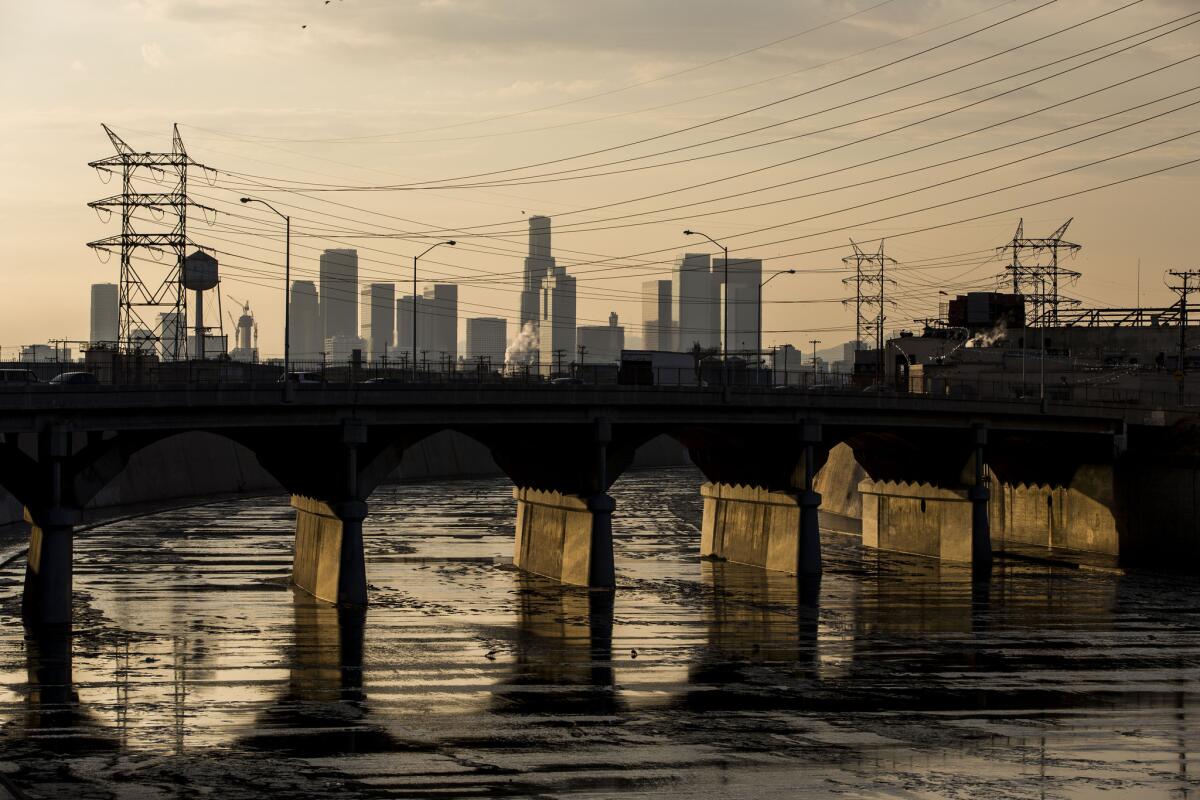Exclusive: Architect Frank Gehry is helping L.A. with its Los Angeles River master plan, but secrecy troubles some

The Los Angeles River as it runs along side of the city of Vernon.
- Share via
Architect Frank Gehry is working with city officials to draft a new master plan for the redevelopment of the Los Angeles River, bringing the avant-garde sensibilities of one of the world’s best-known artistic celebrities to the struggle to remake 51 miles of the Los Angeles Basin’s largely desolate central waterway.
Gehry’s designs for the flaring steel walls of the Guggenheim Museum in Bilbao, Spain, and the Walt Disney Concert Hall in Los Angeles have become icons of contemporary architecture. Since last year, he has been quietly at work on what officials describe as the beginnings of an overarching plan for the bridges, bike paths, walkways and other improvements intended to revive public use of the river as it winds from the San Fernando Valley to Long Beach.
Many details of the Los Angeles-based architect’s vision remain under wraps. Mayor Eric Garcetti and the L.A. River Revitalization Corp., a nonprofit group created to coordinate the renewal effort, had not planned to announce Gehry’s role until later this month. After The Times disclosed Gehry’s involvement Friday, Garcetti said the architect is working on the project pro bono and producing “a master plan, in the truest sense of the word.” The mayor compared it to the work of famed urban designer Frederick Law Olmsted, who created New York City’s Central Park.
“To have the Olmsted of our time focusing on this, I think, is extraordinary,” Garcetti said at an unrelated City Hall news conference.
Gehry’s involvement marks a potential turning point in a decades-long struggle to reinvent the river and its concrete-lined banks. But his plan is getting a cold reception from some of the activists who helped draw attention to the cause.
Some express concern about the secrecy surrounding Gehry’s work and the lack of public input on what could be a far-reaching blueprint for the river’s future. They also warn that announcing a new direction for river redevelopment might imperil federal funding for a $1.4-billion, 11-mile restoration project in northeast Los Angeles and downtown.
Those concerns came to a head this week, when Friends of the Los Angeles River, the nonprofit group led by Lewis MacAdams, sent a letter to the River Revitalization Corp. refusing to endorse the Gehry effort. The letter also said the river environmental group would not take part in a news conference announcing the architect’s plan.
In the letter, a copy of which was obtained by The Times, MacAdams said he feared the “new vision and plan for the river led by Frank Gehry” would “undermine our efforts” to secure funding from the U.S. Army Corps of Engineers and “create confusion among the public and political leadership.”
In an interview, MacAdams said his group’s decision not to endorse the project stemmed partly from philosophical opposition to the sort of top-down land-use planning that led the federal government in the mid-20th century to turn a meandering river into an unsightly drainage channel.
“Last time there was a single idea for the L.A. River it involved 3 million barrels of concrete,” MacAdams said. “To us, it’s the epitome of wrong-ended planning. It’s not coming from the bottom up. It’s coming from the top down.”
Gehry’s office did not respond to requests for comment Friday.
Barbara Romero, deputy mayor for city services, said there would be an extensive outreach process to solicit Los Angeles County residents’ thoughts as Gehry’s work moves forward. She said the process for soliciting such input was “to be determined” and would be handled by the River Revitalization Corp.
Romero said Gehry had been studying the river in conjunction with the Revitalization Corp. since at least last November. She said his work would “build on” the Army Corps-funded restoration project, not interfere with it.
“At the end of the day, the L.A. River is an infrastructure system,” she said. “Having someone like Frank Gehry involved elevates it.”
In a statement, the revitalization corporation said Gehry’s efforts “will expand upon the decades of important work that has come before.... Far from complicating any other efforts, his work will complement those efforts.”
“This project will have a tremendous amount of public input from the diverse talent and ideas of people across the region,” the statement added.
Gehry has designed some of the world’s most recognizable buildings. His most famous structures are characterized by a free-handed sculptural style — the jagged steel profile of Disney Hall that looms over downtown is one example — that has drawn both praise and criticism.
Some were elated at the news of his role in the river overhaul. Architect Kevin Mulcahy of RAC Design Build, which opened four years ago in a warehouse in the riverside Elysian Valley neighborhood, said it was an exciting resolution to the question of who would ensure that the restoration project would have a unified design as it winds through a patchwork of cities and unincorporated county land.
“It ends a years-long street fight,” Mulcahy said, “over who might have the world-class vision and world-class capital to develop a comprehensive plan for transforming the entire river into a 51-mile-long public space.”
Los Angeles’ largely arid concrete riverbed is the latest in a series of urban waterways targeted for redevelopment. The most famous is perhaps the San Antonio River Walk, which attracted more than 9 million non-resident tourists last year and millions more locals.
“Most American cities turned their backs on the water in the 1950s, ‘60s and ‘70s,” said Ed McMahon, senior resident fellow at the Urban Land Institute in Washington, D.C. Today, by contrast, “There’s hardly a city in the country that hasn’t tried to reconnect with its waterfront,” McMahon said. “Some have had more success than others.”
In 2007, Los Angeles officials adopted a river revitalization master plan after extensive public input. Romero said Gehry’s work will flesh out design elements that were left vague.
But in a region and state known for heavy regulatory review of large developments — especially near environmental resources — questions remain about which government agencies will have a say in how Gehry’s vision is implemented.
“It could be the city of Los Angeles with input from the federal government and local agencies or it might be a federal process with the cities as the commenting agencies,” said Douglas Carstens, a Los Angeles-based environmental attorney. “They might turn this into something regional. All of this needs to be coordinated.”
One challenge, Carstens said, will be to balance competing visions of the river as environmental haven — featuring abundant parkland and public access — and as the spine of major urban redevelopment, surrounded by shops and housing.
“If there are differing visions, the conflicts and issues would have to be worked out,” he added. “Frank Gehry might be able to do that.”
[email protected]; [email protected]; [email protected]
Times staff writers Emily Alpert Reyes and Louis Sahagun contributed to this report.
ALSO
What last weekend’s Hard Summer rave looked like to ER doctors
L.A. River art project gets a boost from Michael Bloomberg
Frank Gehry wins Getty Trust’s annual career achievement medal
More to Read
Sign up for Essential California
The most important California stories and recommendations in your inbox every morning.
You may occasionally receive promotional content from the Los Angeles Times.













